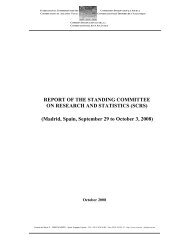E - Iccat
E - Iccat
E - Iccat
Create successful ePaper yourself
Turn your PDF publications into a flip-book with our unique Google optimized e-Paper software.
ICCAT REPORT 2012-2013 (I)<br />
5.2.1 East Atlantic and Mediterranean<br />
The 2011 eastern Atlantic and Mediterranean bluefin tuna catch was 9,779 t, the lowest catch since 1950. Since<br />
2008, a rebuilding plan and enforcement controls have been in place which resulted in a marked decrease in the<br />
catch of mostly young fish in the Mediterranean. The quality and quantity of data and its collection continues to<br />
need improvement.<br />
The SCRS has strong concerns about the catch and catch-at-size quality/quantity of the data, the under-reporting<br />
of fishing CPCs prior to 2007, the impacts of IUU fishing, and the loss of information at the time of caging.<br />
However, both the data quantity and quality is improving with the introduction of individual quotas, better<br />
enforcement of the controls and acquisition of new sources of information (BCDs, ship board observers, VMS<br />
signals, cage site observers and the use of stereoscopic cameras during caging operations).<br />
All CPUE indices displayed positive trends in recent years, including fisheries-independent information from the<br />
aerial surveys performed on juvenile fish in the north-western Mediterranean Sea. Recent regulatory measures<br />
significantly affected the CPUE values through a change of operational patterns. Fisheries-independent surveys<br />
(e.g., aerial and larval surveys) and a large-scale tagging program are needed to provide more reliable stock<br />
status indicators.<br />
The Committee updated the 2010 stock assessment. In addition to improvements in the data quantity and quality,<br />
the assessment methods applied must be modified in the future to better accommodate the substantial<br />
uncertainties in the historical total catch, catch at age, and effort data. Testing of the methodologies envisioned to<br />
improve robustness will require at least three years to complete.<br />
The estimates of current stock status relative to benchmarks are highly sensitive to the selectivity pattern and to<br />
the hypotheses about the recruitment levels. The perception of the stock status has improved in comparison to<br />
previous assessments (F declined in recent years). All runs investigated showed a clear increase of the spawning<br />
stock biomass (SSB), but both the speed and the magnitude of this upward trend remain highly uncertain as these<br />
strongly depend on model specifications.<br />
A higher abundance or higher concentration of small bluefin tuna was observed during aerial surveys conducted<br />
in the north-western Mediterranean. This observation may reflect a response by the stock to an increase in the<br />
minimum size regulation which also partly affected the selectivity patterns for several fleets operating in the<br />
Mediterranean Sea and East Atlantic over the last five years. Improved yields-per-recruit were also observed in<br />
comparison to the early 2000s as well as a greater recruitment to the SSB as a result of the regulation allowing a<br />
higher survival of juvenile fish.<br />
Sources of uncertainties have not yet been fully quantified and these include population structure, migratory<br />
rates, key modeling parameters for bluefin tuna productivity and the fact that it is difficult to take the IUU catch<br />
into account in the Kobe matrices. Despite these unquantified uncertainties, the 2012 updated stock assessment<br />
confirmed the 2010 findings that the recovery plan would enable eastern bluefin tuna to return to B MSY with a<br />
probability of at least 60% by 2022. Current estimates indicate that rebuilding could even be achieved before<br />
2022, and that a slightly higher TAC would achieve the Commission’s objectives. However, given that the speed<br />
and magnitude of the rebuilding of the SSB remains highly uncertain, verification of this outcome needs to be<br />
confirmed by future data and analyses.<br />
5.2.2 West Atlantic<br />
This stock was last assessed in 2010 with slight increases being noted in the stock. The 2012 stock assessment<br />
was an update of the previous analysis.<br />
Virtual population analyses (VPA) were conducted with the same parameter specifications used in the 2010<br />
base-case assessment using the most recent years of available data. Conclusions do not reflect the full degree of<br />
uncertainty in the assessments and projections resulting from stock mixing, recruitment, maturity at age and<br />
catch at age. Many of these deficiencies are being addressed by current research programs.<br />
The Committee has no strong evidence to favour either recruitment scenario over the other. They are viewed as<br />
reasonable (but not extreme) lower and upper bounds on rebuilding potential. The low recruitment scenario<br />
suggests the stock is above the MSY level with greater than 60% probability and catches of 2500 t or lower will<br />
maintain it above the MSY level and if the high recruitment scenario is true, the stock is not expected to reach<br />
the MSY level by 2019 even with no catch.<br />
238

















